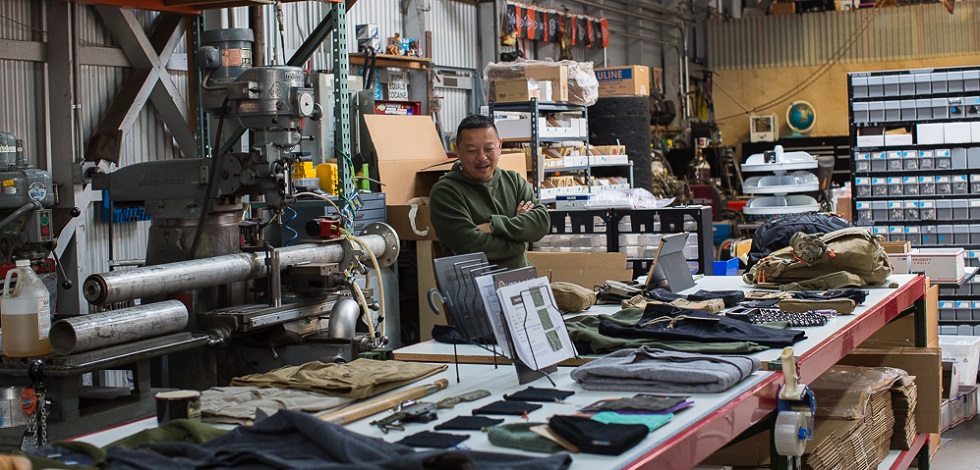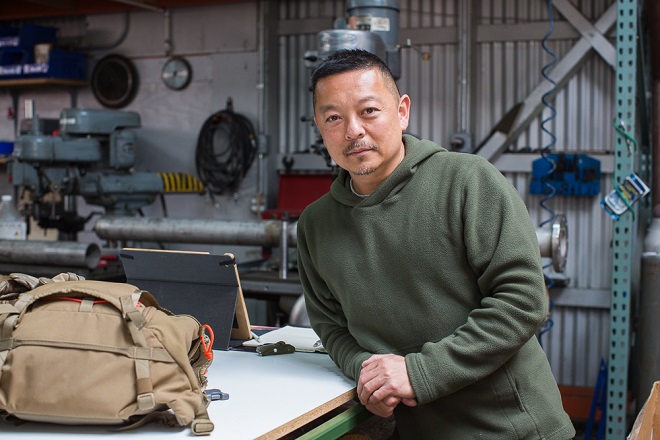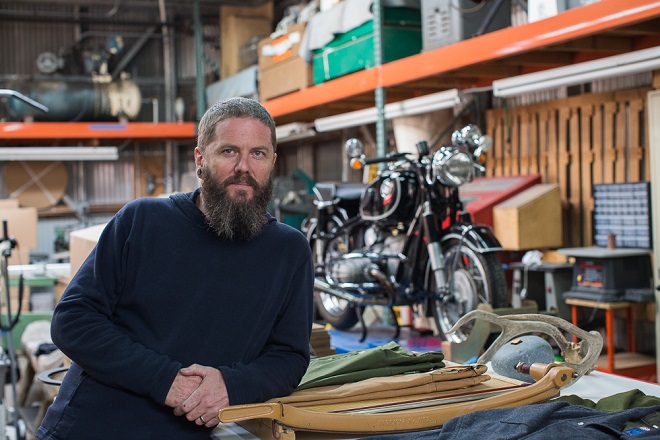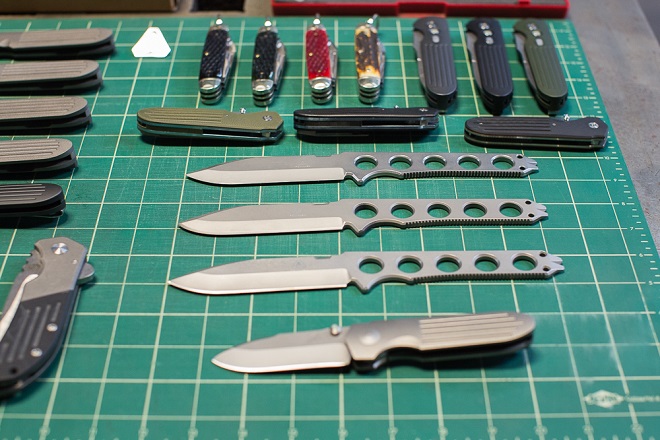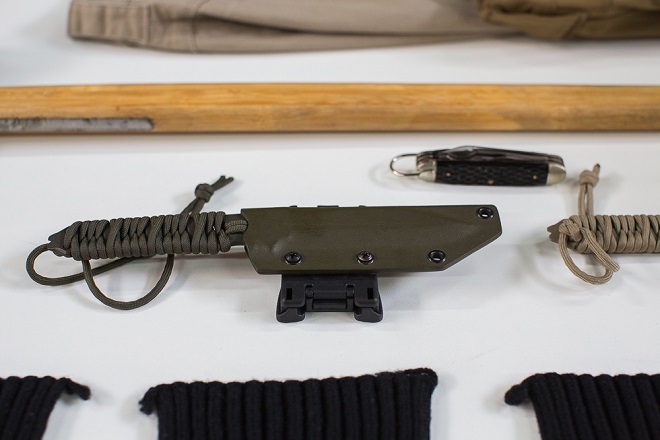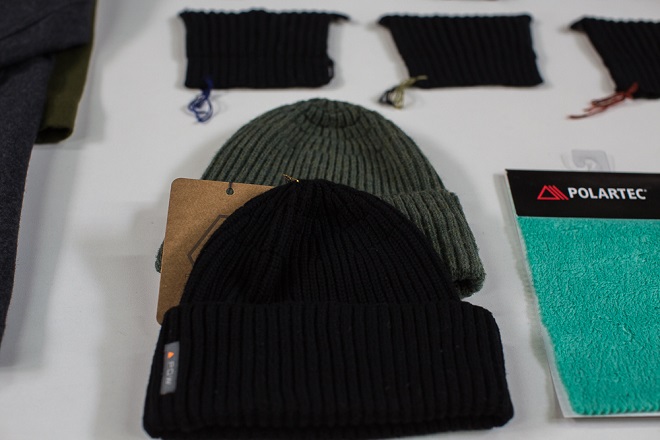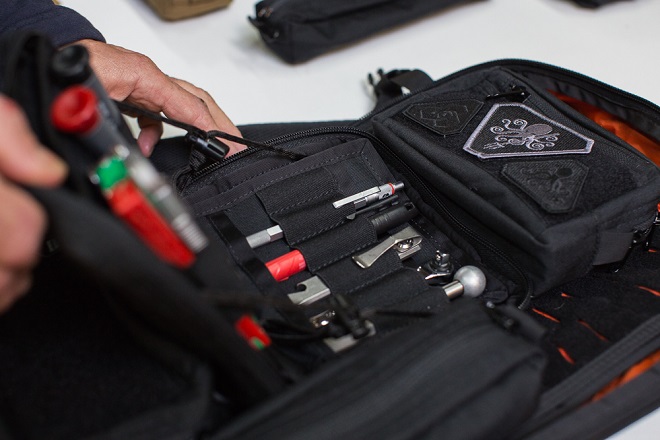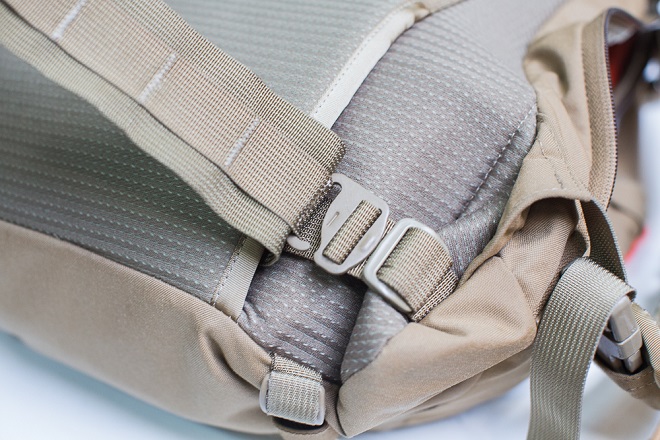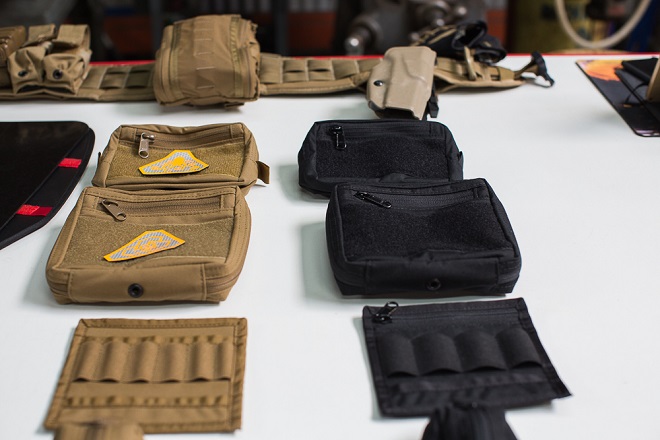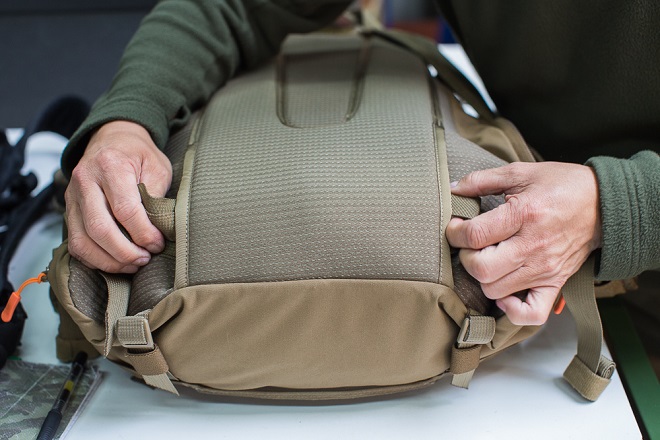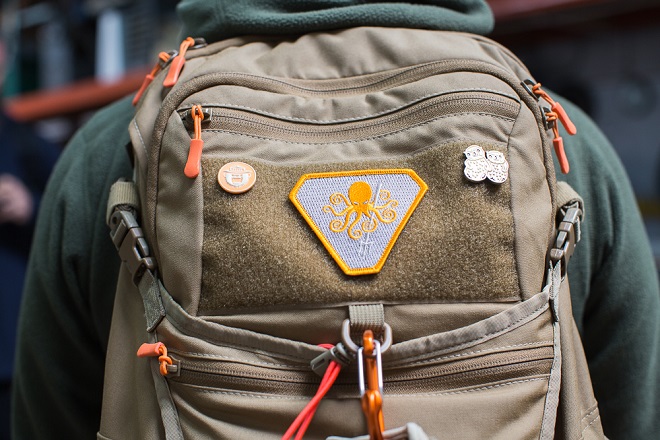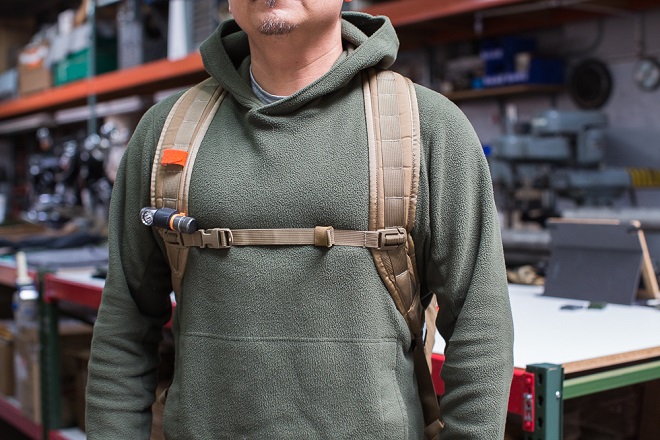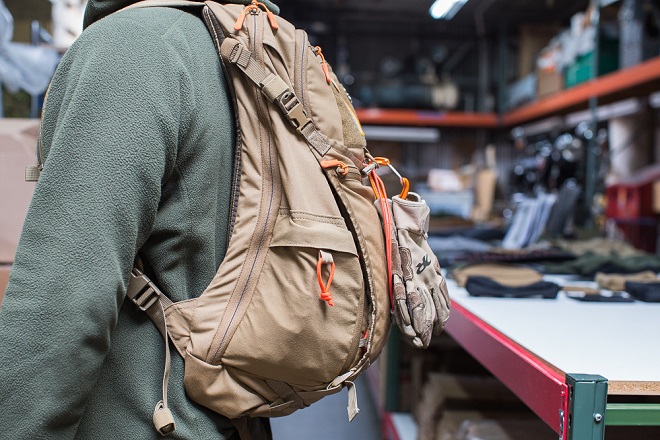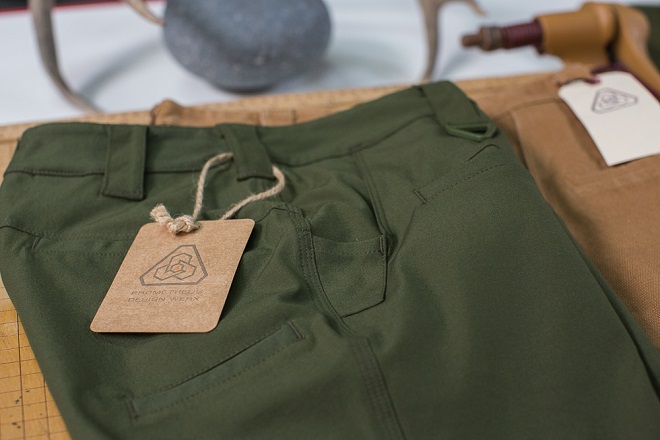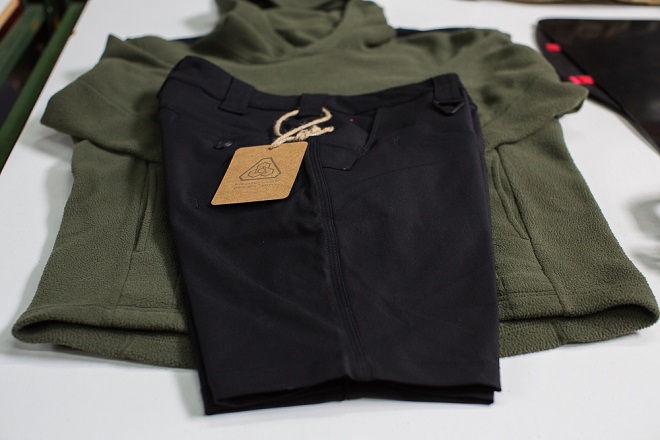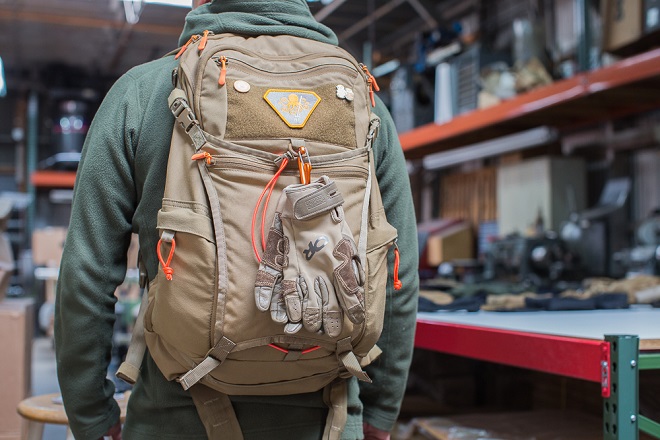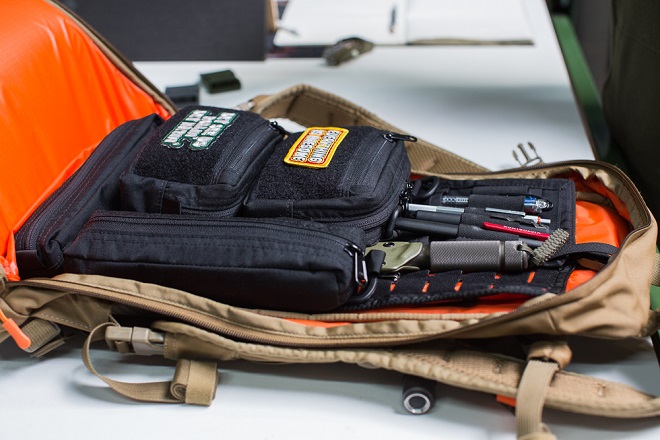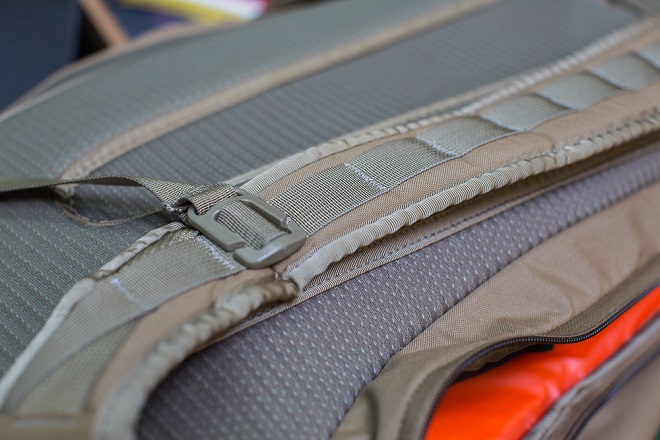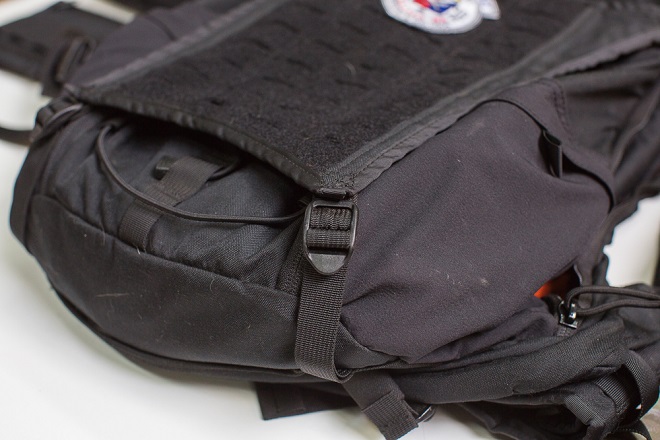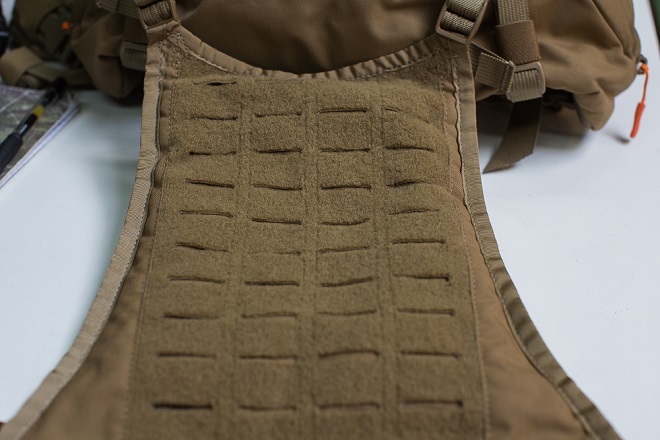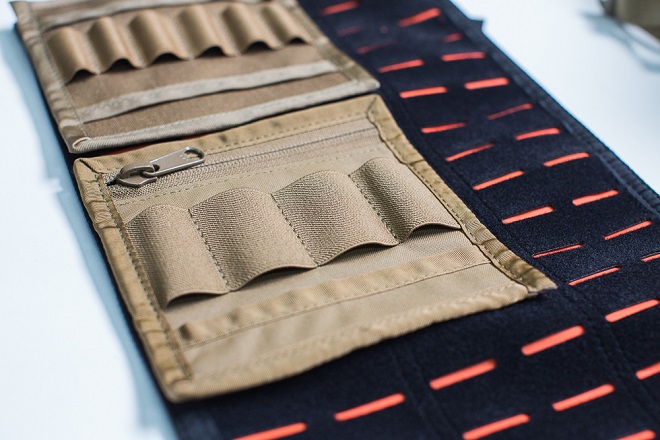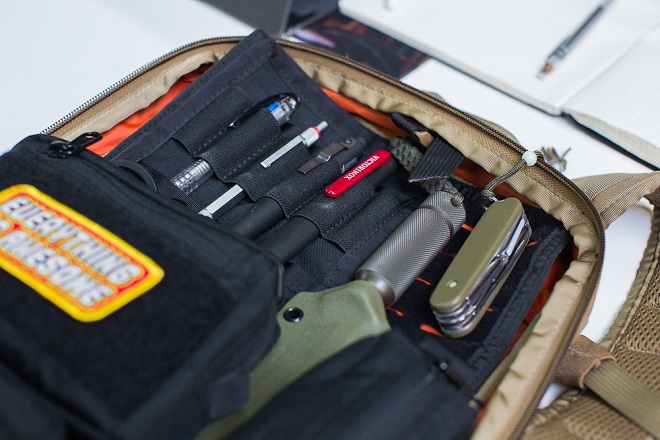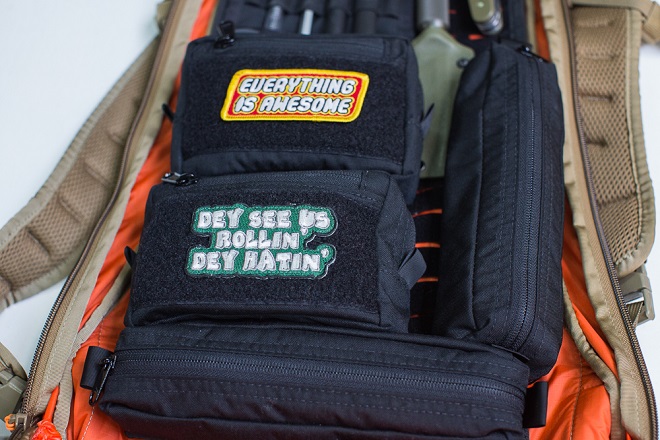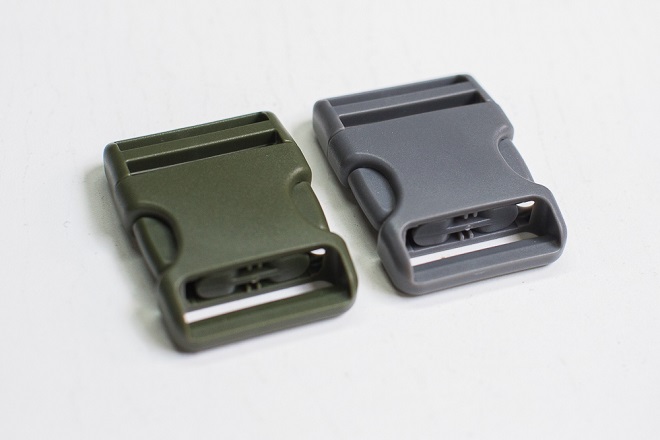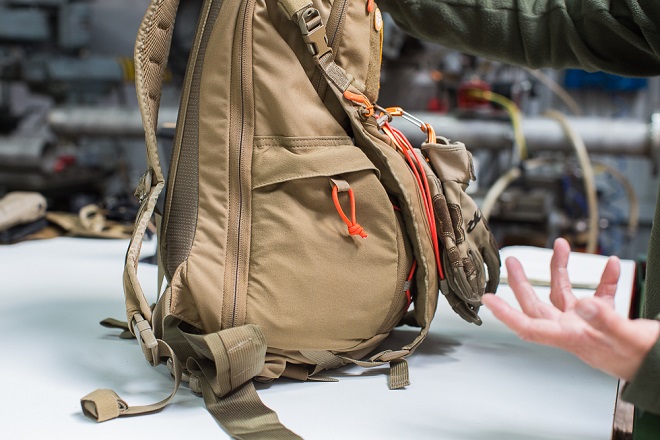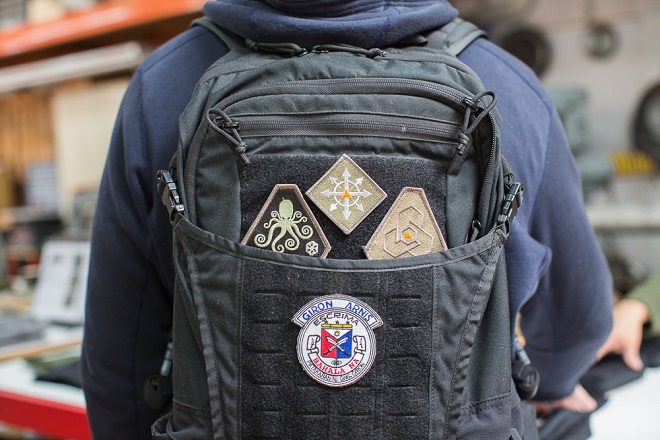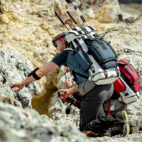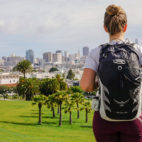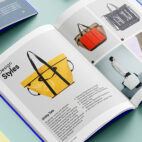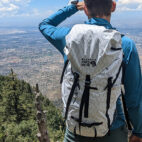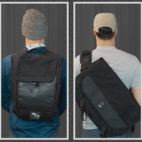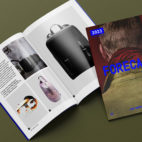Design Heads | Prometheus Design Werx
Fusing a love of the outdoors and a fascination with objects, Patrick Ma has embraced a life full of discovery, exploration, adventure, and design. Taking a utilitarian approach to his designs, he is often considered responsible for bringing tactical products to a larger audience. A desire to create products for outdoor exploration, backpacking, and camping has shaped the underlying lifestyle behind his brands. I sat down with Patrick and co-founder Chris Whitney at their San Francisco HQ to chat about their current venture, Prometheus Design Werx and the S.H.A.D.O. Pack.
How has your career up to this point led to the birth of Prometheus Design Werx?
Patrick: Previously with my first brand Triple Aught Design, which I founded in ’97, it was a shot in the dark. I had a vision, but no experience with the “how to’s”. I was like I’m just going to try to make some stuff and sell it. See how it goes. Before I knew it, I mean, it turned into a formal business. I was very lucky to have the right kind of consumers who picked up on the brand, and this was the very beginning of the whole Internet era. It just happened that the types of core consumers who first picked up on what I was doing were a lot of guys in the shadowy special operations realm. They didn’t want to wear the classic US Woodland camo or the stuff that was available. These guys are the ones who wanted to have the functionality of mountaineering-grade equipment and apparel but not in bright conspicuous color palettes commonly available, OR use what was issued and obviously look like they were “Big Army”. They picked up on the types of purpose-driven, subdued palette technical jackets that I was doing, the very functional pants that I was doing, nylon goods, and the other objects such as knives to billet survival items.
“Previously with my first brand Triple Aught Design, which I founded in ’97, it was a shot in the dark. I had a vision, but no experience with the “how to’s”.”
All these design, use case, functional, and color preference realizations I’ve been developing and evolving in my particular personal sort of narrative about lifestyle and a design ethos starting around the age of 10 or 11. I had a mentor-teacher in school around this time when I was living in the Adirondacks, who was a grisly old-school mountaineer. He showed me the whole world of mountaineering, backpacking, rock climbing, backcountry skiing – what our industry now calls “core outdoor” or “mountain sports”, as opposed to what I was already exposed to, which was the hunting-fishing genre, or what is referred to as the “cast and blast or hook and bullet” outdoor segment. Those are the two sort of dividing general categories of outdoor gear in the industry these days. Being exposed to and participating in all these experiences from an early age really helped shape my life to how I create my designs today. This whole world of outdoor activities just really drove home to me the variety and breadth of what you could do outdoors.
And that led into your previous venture?
Patrick: The whole idea of “tactical equipment” as we see it today was in its very nascent sort of stage at that point. I’ve heard some folks say that I really helped usher in what you would call the tactical products category to the general population. Up until then you had your police supply stores, you had what was available in Army-Navy surplus stores and obviously anything that was issued to you if you are in any of our Armed Forces, but I was able to take some of the best of those existing ideas and update and retool them with the advancements from the core outdoor industry. Now the general population, anybody could purchase and use my unique designs with an extra degree of durability, technical performance, and a different and fresh functional aesthetic. The many other products already on the market that perhaps didn’t quite connect with or resonate with my customers, I now provided, offered that voice.
“Up until then you had your police supply stores, you had what was available in Army-Navy surplus stores and obviously anything that was issued to you if you are in any of our Armed Forces, but I was able to take some of the best of those existing ideas and update and retool them with the advancements from the core outdoor industry.”
Apparel styles that people would now describe as the “tactical softshell”, I have been credited for defining, and I would humbly claim as my idea. Taking what was already being produced as a softshell jacket in the outdoor industry, but then applying a lot of the design and functional details from military and law enforcement uniforms and duty wear. Take for instance the flight style bomber that you’re wearing now, that sleeve pocket. Because if you actually had a backpack, vest, or harness on, you can’t easily get to your chest pockets, so sleeve pockets make a lot of sense. You have items here that you can still get to, so applying those functional military-in-origin design details like a sleeve pocket to a technical outdoor jacket was very apropos for today’s user getting to an iPod, smartphone, even lip balm or an energy bar while on the move, in the field, or on the trail. The sleeve pockets, and adding the military-LE loop swatches for hook & loop morale patches to put on modern performance outerwear, nobody I am aware of had done this before for the general population. Obviously military and police have their unit crests, but with my jacket, fleece designs, and also my embroidered “morale patches” any consumer could now individualize and customize how they wanted to represent themselves and their gear; they could show whatever “tribe” they belonged to.
Designing and working with performance fabrics, materials and modern core outdoor fabrication manufacturing techniques hadn’t really yet caught on with Big Army and police suppliers. For me and where I happened to be at the time, it was timing, and the industry and the consumer and the market seemed ready for what I was offering. I just was in a great place to show an audience this type of functional product aesthetic, this design direction. It really caught on and I ran with it until 2010-2011.
“For me and where I happened to be at the time, it was timing, and the industry and the consumer and the market seemed ready for what I was offering. I just was in a great place to show an audience this type of functional product aesthetic, this design direction.”
What are some key insights to your design and your vision for PDW?
Patrick: PDW is a continuing evolution of a singular design vision that is staying true to itself, and as a business model, uncluttered by stodgy corporate dogma. Being able to evolve and holding true to the authenticity about what a brand is, who we are as individuals, what we are passionate about in life, creative freedoms, lifestyle, are all critical and key in being able to do what I/we do. I believe it is necessary to divorce oneself from any work and staffing environment that is counter to those fundamentals if ever found in one. It was incumbent upon myself to create PDW where a shared lifestyle and product vision would flourish and thrive. We’re not about being locked down by old definitions that some might consider. It’s about continuing to blaze your trail, walking one’s own path, staying true and yet looking ahead. PDW is a brand and a breadth of products that are much more pluralistic in how you choose to live your life.
“Being able to evolve and holding true to the authenticity about what a brand is, who we are as individuals, what we are passionate about in life, creative freedoms, lifestyle, are all critical and key in being able to do what I/we do.”
Yeah, we’re shooters. We enjoy that community, I grew up in it, been around it all my life. We go out and we hit the range, train and other opportunities as they present themselves.
When not working and designing-developing new products, we go backpacking, camping with the kids, overlanding, getting out there and doing field projects with people who we know, scientists, geologists, biologists; as often as we can. I’ve had the great fortune of traveling to most of the continents at this point working on field projects typically in wildlife conservation. Most recently we’ve been engaged in anti-poaching work in Latin America. That’s not what you would consider tactical per say, but the equipment-apparel-products we produce still applies. Our products must be rugged and reliable without weighing you down, technical and performance driven, clean styling; they’ve got to withstand traveling on the racks of busses, all manner of airplanes, 4x4s, being able to hike, climb, go through the brush and jungle; the equipment you use has to survive and it’s got to perform for you.
“Our products must be rugged and reliable without weighing you down, technical and performance driven, clean styling…”
How do you differentiate your brand from the rest?
Patrick: The difference I would say, that is really I think the most salient, is that we allow ourselves a greater degree of latitude in regards to how we want to design and then use our products; as opposed to being pigeonholed by what you would constrain by just describing as tactical to hunting, or even backpacking. Each of those descriptives defines a consumer subculture at this point. We’re not interested in being constrained or confined by just utilizing any one of those terms to blanket define who we are. Ultimately, this is adventure gear in the best and broadest sense; to use as you see fit and living a life on your own terms. A life less ordinary. Helping others to help themselves to live a more fulfilled life in the true spirit of adventure at the very core. If you want to use our products to bike-bike-climb, stage a dive, explore an ancient jungle ruin, go shooting, bag a peak, go wheeling, discover an epic new point break, great. If you’re doing private contract work, want to go pursue some rare species of mammal to save in Australia, if you’re a doctor traveling to some remote part of the world to do humanitarian work, to the US Government agencies and elements in DOD we continue to work with, we are a brand that this caliber of user(s) goes to. We’re not big box, we’re not mass production, we’re not stuck in one corner. We strive to create feature-rich designs and use the finest materials. We truly love what we design and make, and using it. A while back a few employees of another brand in our space were lamenting to us how they received an email from their superiors informing the staff of a “mandatory company camping trip” and that they were “required to have fun”. Those of us who were hearing this had a good chuckle over it, then thought to ourselves, what kind of brand would ever have to say that to its employees. PDW is certainly not that. We get out and seek adventure in every aspect of our lives and we’re creating the gear and apparel to do it.
“Ultimately, this is adventure gear in the best and broadest sense; to use as you see fit and living a life on your own terms. A life less ordinary.”
We love the colors found in nature but we tend to punctuate our products with hits of brighter colors in an overall subdued palette as opposed to making it entirely colorful outright. With a lot of these details in our goods, the consumer again can dial in and customize how they want it. Ultimately, these are products that help you with how you want to define your life. The goods you own and use should not define who you are. You define your own life by your actions and deeds. Products and goods should accentuate and accessorize how you want to live that life.
Chris: I think everything that we do is infused with the actuality of our usage of it. I mean look around the room. It’s like when you came in, Patrick pointed out the manual nature of everything that’s here. We’re very manual, tactile designers and craftsmen, and so all of the products that we produce and put out are infused with the fact that we do a great many things by hand and we have a great amount of experience and understanding with a lot of different processes that involve the use of the hands. We’re not the same tea shop. We don’t just generate 3D models of things and have a machine spit them out. We’re fully engaged in the process of what all of these objects become. We touch them. We handle them. If we work with somebody and they’re doing something for us, but we want to take it to the next step further, we do it ourselves. Everything that we make, we understand its usage because we participate on it on many levels, if not all levels.
“We’re very manual, tactile designers and craftsmen, and so all of the products that we produce and put out are infused with the fact that we do a great many things by hand and we have a great amount of experience and understanding with a lot of different processes that involve the use of the hands.”
So as part of your process you actually wear test it yourselves?
Patrick: Absolutely. We don’t make anything that doesn’t speak to ourselves personally and that we wouldn’t use ourselves. If we don’t use it ourselves, it gets tossed out. It doesn’t even see the light of day. If we can’t use what we make, it doesn’t get done. If we don’t love what it is that we’re wearing, using, cutting with, putting stuff into, hiking with, camping with, we’re not going to make it.
“We don’t make anything that doesn’t speak to ourselves personally and that we wouldn’t use ourselves.”
Chris: And we really do. I mean right now I can go get my pack, open it up and show you. It’s loaded out with tools because I want to see how our product holds up to the daily use of lugging around tools. I have all of the little tools that I would need for anything that we might do here with regard to our hard goods and just things that would help me in any particular situation day-to-day.
In terms of the future of the brand and direction is it to create more timeless, iconic, staple pieces?
Patrick: Yeah. I mean everything that we’re doing right now is core basics. I mean we rock this stuff every day. We’re creating today’s modern classics that are defining our brand and lifestyle. We don’t get behind the flash-in-the-pan garish design trends. We do our thing based on a variety of sensibilities and often unintentionally create our trends in our industry. While our designs are clean and streamlined, they’re never short on features. For example our EDC Shorts, they’re plain-looking shorts but have 11 pockets. These aren’t your big box store type walk shorts.
That’s incredible. Did you design it with everyday carry in mind?
Patrick: Absolutely. These look like a really great pair of tailored Bermuda style shorts but made out of awesome four-way stretch DWR nylon fabric, and the many pockets accommodate your modern user – smartphones, earbuds, pocket knives, multi-tools. There’s a pocket for all that stuff. I mean 11 pockets in these shorts…being able to clip on keys and other little things.
Which brings us to the latest pack from PDW, the S.H.A.D.O.
Patrick: So the S.H.A.D.O. Pack. From the design perspective, you always have to start out with writing down what your top-level criteria are that you want to achieve with that design. So, you can apply it to anything. In this particular case, a backpack. What does it need to have? Well, it needs to have a full Suspension which includes a versatile and removable modular waistbelt. It needs to be able to be Hauled in any number of ways. Oftentimes, when I’m traveling and moving a pack from roof racks, cargo hold, etc. you’ll notice that you only have one handle on a pack to grab. It can be difficult for the porter or for the bus driver. He is the one who will grab it. So being able to grab it from either end with the top handle or the other one on the bottom just allows a lot easier handling when you’re traveling. We want to make sure that that aspect is covered for the user and handler.
“Oftentimes, when I’m traveling and moving a pack from roof racks, cargo hold, etc. you’ll notice that you only have one handle on a pack to grab. It can be difficult for the porter or for the bus driver. He is the one who will grab it. So being able to grab it from either end with the top handle or the other one on the bottom just allows a lot easier handling when you’re traveling.”
And then Access, being able to get your gear quickly. It’s got to be Durable enough but not weigh you down and feel like a burden to carry. There’s some really good backpacks out there. I look at everything. I love packs-bags. I love useful, well designed clothing. I love knives, cars, motorcycles, tools. The packs out there which are, you know, one pound two ounces whatever, and it just won’t last if you’re really out there and travel for a month or more. When we’re out on the field most people spend three days out. When I’m doing my field projects I’m out for weeks, almost a month at a time. Your stuff has to hold up. If it breaks down and you’re in the middle of nowhere you –
Chris: You got nothing.
“It’s got to be durable enough but not weigh you down and feel like a burden to carry.”
Patrick: Then O for Organized. With all the great variety of gear that you can have now as a consumer, multi-tools, batteries to charge up your devices, portable devices, optics, camera equipment, personal effects such as I’m in the middle of nowhere and I can’t make it to my hotel tonight, I’m going to be stuck out in the field. I want to brush my teeth. So, you want to have some of those basic personal effects. So, this pack design took all of these points into consideration for today’s user, and I designed a unique dedicated zippered compartment and optional accessories just to organize one’s EDC gear in a pack without any of it getting in the way.
So the S.H.A.D.O. name for this pack came from those terms in the design criteria and what we were making.
We love it. This is a versatile full-sized daypack for field and EDC. It might be a bit big for some EDCers at 28L, but we wanted to make sure it could handle an overnighter on the trail. We shaved I would say almost half the weight on this pack versus my first daypack I did over 10 years ago. That first pack I did dry-weight without any stuff in it was heavy. It was great for its intended purpose when I designed it almost ten years ago. I’ve moved on, way on. So have my customers.
“This is a versatile full-sized daypack for field and EDC. It might be a bit big for some EDCers at 28L, but we wanted to make sure it could handle an overnighter on the trail.”
The S.H.A.D.O. Pack is a pack that reflects how I live my life now, how I’ve progressed and applied the many lessons learned. It’s way more comfortable in terms of how I want to apply my carry methods in our context now. This pack’s shape is based on many of your modern outdoor alpine packs or summit assault packs as you would call it, its core DNA is an outdoor pack. It’s designed with those considerations, but what makes it unique is that we certainly considered and took into account how everyday carry users wanted to be able to organize all their stuff. This pack here not only has a main compartment. There is a very classic outdoor beavertail. You can put a bump helmet here, bulky rope, a jacket. It’s also a great place to store a tablet or scarf. I always have one with me. Living in San Francisco it can be 80 degrees one day and 50 degrees the next, so it’s always great to have these things with you.
“This pack’s shape is based on many of your modern outdoor alpine packs or summit assault packs as you would call it, its core DNA is an outdoor pack. It’s designed with those considerations, but what makes it unique is that we certainly considered and took into account how everyday carry users wanted to be able to organize all their stuff.”
Chris: Our micro-climate weather can be crazy. Those temperature variances can happen in the course of a day.
Patrick: Yeah, a day. The Gear Trap is reversible. It still accommodates and accepts MOLLE-compatible accessories, which I think is a really smart system and everybody has approached different ways to make improvements on it. I think the only disadvantage at this point with traditional MOLLE is that it’s really heavy. You have to have these straps. These do add weight and make it all work, but in terms of its modularity and its organizational intent, overall it’s really brilliant in its simplicity and execution. For many being able to have the main compartment as a clamshell opening, this is probably the most efficient way to access your equipment at once inside. We have our pack lined with international orange oxford nylon so it’s easy to see the internal contents, and can be used to signal in an emergency. Also inside the main compartment is a padded sleeve for a 15-inch Mac or iPad Pro.
“We have our pack lined with international orange oxford nylon so it’s easy to see the internal contents, and can be used to signal in an emergency.”
Is it padded?
Patrick: Yeah. It’s padded. Nothing about this pack is, I want to say, is overkill. We wanted it durable, but didn’t want it too heavy at the same time. We want it to be fast and lightweight but still offer organization and storage, and be big on functionality and field ability. What really makes our pack is our EDC Organizer Compartment, which sits behind the main compartment. We have a separate clamshell compartment in the back of the bag where you can go ahead and use what we call the other options such as our EDCO panel. It’s the EDC organizer panel that you mount on the top. All these pouches and third-party brand pouches you see will fit on this organizer and keep things out of the way most of the day and accessible when you want it. Everyone can dial in how they want to organize their EDC items in this compartment. So, if this pack is all buttoned up, what is it that I want to access first and foremost? It’s going to be stored in the top so I have my pens and pencils and things that I use the most here, right? I have my two knives here. If this wasn’t here I’d probably have a battery pack for my charger to charge my phone. If you wanted to get something that you want to have on you, but probably typically would use less frequently, I would have it on the bottom, so then you can go ahead and open the pack all the way. If you’re traveling overnight, that’s where I keep all my charging stuff because you don’t use this typically, but rather maybe every couple of hours. Here I keep a first aid kit which I just want to have with us for camping or hiking.
“We have a separate clamshell compartment in the back of the bag where you can go ahead and use what we call the other options such as our EDCO panel. It’s the EDC organizer panel that you mount on the top.”
What’s the future for this pack?
Patrick: It’s only available now in two colors. We are planning on releasing OD Green and Wolf Gray in January 2017, they are currently in progress. We spent a great deal of time making sure the details are there. So, the hardware, the loop, proprietary stretch fabric.
What makes that special?
Patrick: We have the only US made pack that has stretch water bottle pockets. It’s just a really weird piece of trivia but there is no other US made pack that has stretch fabric water bottle pockets which are found in every single high-end quality pack made today.
That comes in handy. I’m excited to see what else comes out in the near future.
Patrick: Thanks, we have a lot more on deck and this just represents some of what’s to come.





 Carry Awards
Carry Awards Insights
Insights Liking
Liking Projects
Projects Interviews
Interviews
